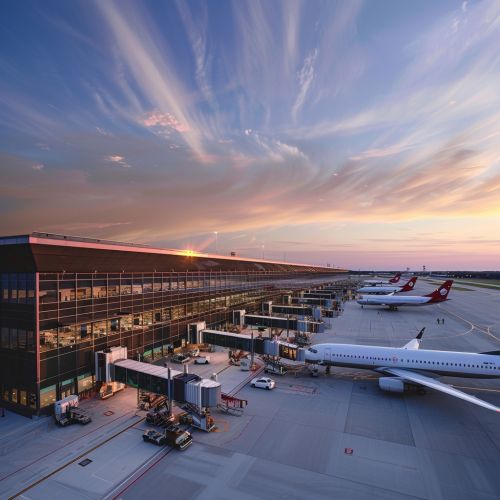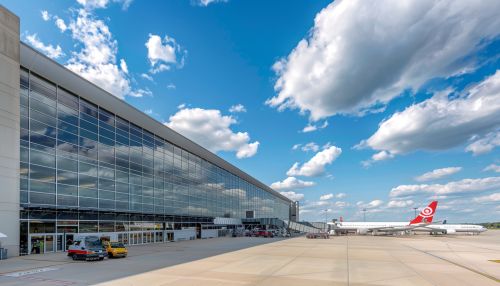John Glenn Columbus International Airport: Difference between revisions
(Created page with "== Overview == John Glenn Columbus International Airport (CMH) is a major public airport located in Columbus, Ohio, United States. It serves as a significant hub for air travel in the Midwest, providing both domestic and international flights. The airport is named after John Glenn, a distinguished astronaut and U.S. Senator from Ohio. == History == The airport was originally established in 1929 as Port Columbus Airport. It was developed to serve as a transcontinental a...") |
No edit summary |
||
| Line 68: | Line 68: | ||
The airport is investing in advanced technologies to streamline operations, enhance security, and provide a seamless passenger experience. | The airport is investing in advanced technologies to streamline operations, enhance security, and provide a seamless passenger experience. | ||
[[Image:Detail-96027.jpg|thumb|center|Exterior view of John Glenn Columbus International Airport terminal building with aircraft parked at gates.|class=only_on_mobile]] | |||
[[Image:Detail-96028.jpg|thumb|center|Exterior view of John Glenn Columbus International Airport terminal building with aircraft parked at gates.|class=only_on_desktop]] | |||
== See Also == | == See Also == | ||
Latest revision as of 01:51, 4 July 2024
Overview
John Glenn Columbus International Airport (CMH) is a major public airport located in Columbus, Ohio, United States. It serves as a significant hub for air travel in the Midwest, providing both domestic and international flights. The airport is named after John Glenn, a distinguished astronaut and U.S. Senator from Ohio.
History
The airport was originally established in 1929 as Port Columbus Airport. It was developed to serve as a transcontinental air-rail service hub, connecting passengers from the East Coast to the West Coast. Over the decades, the airport has undergone several expansions and renovations to accommodate increasing passenger traffic and advancements in aviation technology.
Early Years
In its early years, Port Columbus Airport was a critical link in the Transcontinental Air Transport (TAT) system, which combined rail and air travel to provide coast-to-coast service. The airport's strategic location made it an essential stop for early aviation pioneers and commercial airlines.
Mid-20th Century Developments
During World War II, the airport played a vital role in supporting military operations. Post-war, the airport saw significant growth in commercial air travel. The 1950s and 1960s marked a period of rapid expansion, with the construction of new terminals and runways to accommodate jet aircraft.
Recent Developments
In 2016, the airport was renamed John Glenn Columbus International Airport in honor of John Glenn. Recent developments include modernizing terminal facilities, enhancing passenger amenities, and improving airfield infrastructure to support larger aircraft and increased traffic.
Facilities
John Glenn Columbus International Airport boasts a range of facilities designed to enhance passenger experience and operational efficiency.
Terminals
The airport has a single terminal building divided into three concourses: Concourse A, Concourse B, and Concourse C. Each concourse is equipped with modern amenities, including dining options, retail stores, and lounges.
Runways
The airport features two parallel runways: Runway 10L/28R and Runway 10R/28L. These runways are capable of handling a wide variety of aircraft, from small regional jets to large international airliners.
Cargo Facilities
In addition to passenger services, John Glenn Columbus International Airport is a vital cargo hub. The airport has dedicated cargo facilities that handle a significant volume of freight, supporting the region's economy.
Operations
The airport operates 24/7, with a robust schedule of flights operated by major airlines, regional carriers, and cargo operators.
Airlines and Destinations
John Glenn Columbus International Airport is served by several major airlines, including American Airlines, Delta Air Lines, Southwest Airlines, and United Airlines. The airport offers nonstop flights to numerous destinations across the United States and select international locations.
Air Traffic Control
The airport's air traffic control tower is equipped with state-of-the-art technology to manage the complex airspace efficiently. The tower coordinates with the Federal Aviation Administration (FAA) to ensure safe and orderly flight operations.
Economic Impact
John Glenn Columbus International Airport is a significant economic driver for the Columbus region. It supports thousands of jobs and generates substantial economic activity through passenger spending, cargo operations, and airport-related businesses.
Employment
The airport directly and indirectly supports a wide range of employment opportunities, from airline staff and airport operations personnel to retail and hospitality workers.
Economic Contributions
The airport contributes billions of dollars to the local economy annually. This includes direct spending by passengers, airline operations, and the economic multiplier effect of airport-related activities.
Environmental Initiatives
John Glenn Columbus International Airport is committed to sustainability and environmental stewardship. The airport has implemented various initiatives to reduce its environmental footprint.
Energy Efficiency
The airport has invested in energy-efficient lighting, heating, and cooling systems to minimize energy consumption. Solar panels and other renewable energy sources are also being explored.
Waste Management
Comprehensive waste management programs are in place to reduce, reuse, and recycle waste generated at the airport. This includes recycling programs for passengers and airport operations.
Noise Abatement
The airport works closely with local communities to implement noise abatement procedures, minimizing the impact of aircraft noise on surrounding neighborhoods.
Future Plans
John Glenn Columbus International Airport has several future projects aimed at enhancing its infrastructure and services.
Terminal Expansion
Plans are underway to expand the terminal facilities to accommodate growing passenger numbers and improve the overall travel experience.
Runway Enhancements
Runway enhancements are planned to increase capacity and support the latest generation of aircraft, ensuring the airport remains competitive and efficient.
Technological Upgrades
The airport is investing in advanced technologies to streamline operations, enhance security, and provide a seamless passenger experience.


See Also
References
- John Glenn Columbus International Airport official website
- Federal Aviation Administration (FAA) reports
- Historical archives of Port Columbus Airport
